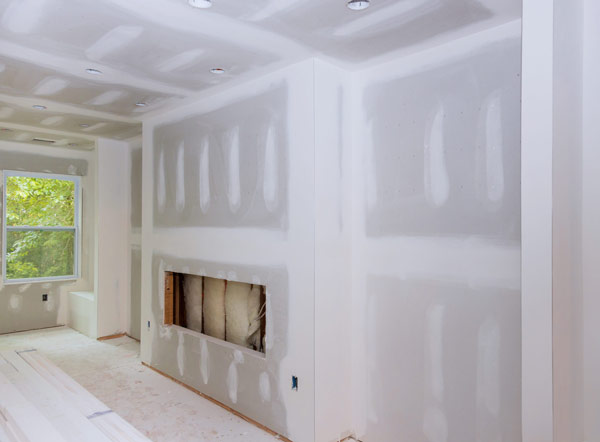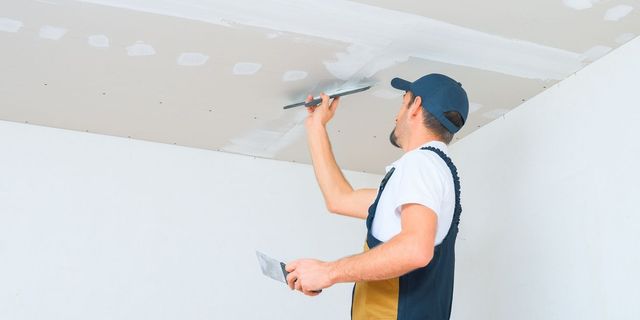Step-by-Step Approaches to Achieving Flawless Drywall Fixing and Setup
Accomplishing remarkable drywall repair work and installation needs an organized technique. It entails understanding the various kinds of drywall and the devices essential for the task. Appropriate location preparation is vital prior to beginning any type of work. drywall contractor. Each step, from covering openings to installing new sheets, demands focus to detail. The procedure does not finish with installment; completing techniques are vital for a polished look. The next steps will guarantee a smooth result, however exactly what do they require?
Understanding Drywall Types and Equipment Needed

The installation tools are just as crucial. An energy blade is essential for cutting drywall sheets, while a drywall saw can assist in making accurate cuts for components or outlets. T-squares ensure exact measurements, and drywall screws or nails protect the panels to wall studs. In addition, a drywall lift can promote the setup of big sheets, lessening physical stress. Familiarity with these tools and types significantly contributes to the effectiveness and top quality of drywall tasks.
Preparing the Location for Fixing or Installment
Preparing the location for drywall repair service or installation is essential to guarantee a reliable and smooth process. First, the surrounding space ought to be free from furniture and various other barriers to provide adequate functioning area. This not just assures safety yet likewise avoids damage to belongings. Next, it is necessary to cover the floor with drop cloths to catch any type of debris or dust created during the work.
Furthermore, the walls should be evaluated for any loose paint or wallpaper that might hinder adhesion. Getting rid of these components produces a tidy surface area for the brand-new drywall. Prior to beginning, it is recommended to shut off power to electric outlets or fixtures around. Guaranteeing appropriate lights in the work area will certainly even more enhance presence and emphasis throughout the repair service or setup process. drywall contractors. By thoroughly preparing the location, one lays the foundation for an effective drywall task
Step-by-Step Process for Patching Holes

Covering holes in drywall requires a systematic technique to assure a smooth fixing. The initial step includes examining the size of the hole. For little holes, a patching substance may be adequate, while bigger openings demand a spot. Next, the broken location must be cleaned up and prepared by eliminating any loose debris.
For tiny holes, using spackling substance with a putty blade is suggested, smoothing it over the opening and feathering the edges. As soon as completely dry, sanding the location ensures a smooth finish. For bigger openings, a drywall spot must be reduced to size, placed over the hole, and protected with screws. After setting up the spot, the same spackling procedure is duplicated, adhered to by about his fining sand.
The patched area should be topped and painted to match the surrounding wall surface. This precise procedure guarantees a specialist appearance and extends the lifespan of the repair service.
Setting Up New Drywall Sheets: A Comprehensive Overview
Installing new drywall sheets requires cautious preparation and execution to ensure a aesthetically appealing and sturdy surface. Initially, the location needs to be measured precisely to figure out the variety of sheets required. It is vital to choose the ideal thickness, commonly 1/2-inch for indoor walls and 5/8-inch for ceilings or fire-rated applications.
Next off, the studs or structure ought to be evaluated for any abnormalities, seeing to it they are aligned and correctly spaced. When positioning the drywall sheets, they need to be positioned flat to reduce joints and boost structural stability. A drywall lift can be advantageous for above setups.
Attaching the sheets with drywall screws at ideal periods makes specific a safe and secure setup. It is necessary to countersink the screws a little listed below the surface area to get ready for the ending up process. Following these standards will cause a strong structure, prepared for the following steps in drywall completing.
Ending Up Touches: Insulation, Mudding, and Fining Sand Methods
Once the drywall sheets are firmly fastened, the emphasis shifts to the finishing touches that will certainly offer a polished appearance. This procedure starts with taping, using either paper or fiberglass harmonize tape to cover the seams in between sheets. The tape ensures a smooth shift, minimizing the danger of cracking. Adhering to taping, mudding is vital; a joint compound is applied over the tape to fill spaces and produce a seamless surface. Normally, numerous coats are needed, every one feathered out additionally than the previous to decrease visibility.
After sufficient drying out time, sanding is the final action in achieving a advice remarkable finish. A fine-grit sandpaper is utilized to smooth the dried out compound, ensuring there are no flaws or bumps. Attention to detail throughout this stage is considerable, as it greatly affects the total appearance of the wall surface. Completion result should be an even, professional-looking surface area ready for priming and painting.
Frequently Asked Questions
Just how Do I Choose the Right Drywall Density for My Project?
To choose the ideal drywall density, think about the task's objective, place, and structural needs. learn this here now Requirement densities include 1/2-inch for general usage and 5/8-inch for fire-rated applications, making certain durability and conformity with building regulations.

Can I Install Drywall Over Existing Drywall?
Yes, mounting drywall over existing drywall is possible. Nevertheless, it is essential to ensure the underlying surface is protected and free from damage. Appropriate fastening and factor to consider of density are essential for a successful installment.
What Are the Best Practices for Drywall Disposal?
The best practices for drywall disposal include recycling when possible, utilizing regional waste monitoring solutions, and adhering to guidelines for dangerous products if relevant. drywall contractors. Properly classifying and sealing waste guarantees compliance and security throughout disposal
How much time Should I Await Mud to Dry Before Fining sand?
Generally, one ought to wait 1 day for drywall mud to dry before sanding. However, drying out time can differ based upon moisture and temperature, so examining for a company structure is recommended before proceeding.
Exist Eco-Friendly Drywall Options Available?
Yes, environment-friendly drywall alternatives are readily available. These options usually make use of recycled products, low-VOC adhesives, and lasting manufacturing techniques, lowering environmental influence while supplying effective insulation and toughness for numerous building and renovation jobs.
An energy knife is crucial for cutting drywall sheets, while a drywall saw can assist in making specific cuts for outlets or components. Preparing the location for drywall repair service or installation is crucial to ensure a effective and smooth procedure. Covering holes in drywall calls for an organized technique to ensure a smooth fixing. Installing brand-new drywall sheets calls for careful planning and execution to guarantee a aesthetically appealing and durable coating. Yes, mounting drywall over existing drywall is possible.